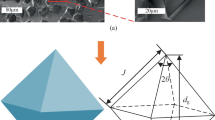Abstract
Surface/subsurface crack during grinding limits the application of engineering ceramics. High-speed grinding is proposed in ceramics grinding for high material removal rate and surface quality. The dynamic fracture toughness of ceramic materials is established by combining the Johnson-Holmquist 2 damage model for brittle material and the Griffith fracture theory. Single-grit simulation was utilized to investigate the individual crack generation and propagation in silicon carbide (SiC) indentation and engagement under different wheel surface speed. The indentation simulation results indicate that high-speed grinding enhances the SiC plastic deformation in the contact zone. Engagement simulation shows that the micro-crack transforms from deep and narrow longitudinal crack in the subsurface to shallow and width lateral crack on the surface when the wheel surface speed increases with a constant maximum undeformed chip thickness. To validate this model, the high-speed grinding experiments are conducted. The trends of micro-crack evolution, single grit force, and surface roughness of the experimental results at the constant workpiece feed rate match well with the simulation results.
Similar content being viewed by others
References
Li K, Liao TW (1996) Surface/subsurface damage and the fracture strength of ground ceramics. J Mater Process Technol 57:207–220
Rao PV, Agarwal S (2005) A new surface roughness prediction model for ceramic grinding. Proc Inst Mech Eng B J Eng Manuf 219(11):811–819
Zhang B, Zheng XL, Tokura H, Yoshikawa M (2003) Grinding induced damage in ceramics. J Mater Process Technol 132(1–3):353–364
Agarwal S, Rao PV (2008) Experimental investigation of surface/subsurface damage formation and material removal mechanisms in SiC grinding. Int J Mach Tools Manuf 48(6):698–710
Agarwal S, Rao PV (2010) Grinding characteristics, material removal and damage formation mechanisms in high removal rate grinding of silicon carbide. Int J Mach Tools Manuf 50(12):1077–1087
Agarwal S, Rao PV (2012) Predictive modeling of undeformed chip thickness in ceramic grinding. Int J Mach Tools Manuf 56:59–68
Agarwal S, Rao PV (2010) Modeling and prediction of surface roughness in ceramic grinding. Int J Mach Tools Manuf 50(12):1065–1076
Agarwal S, Rao PV (2013) Predictive modeling of force and power based on a new analytical undeformed chip thickness model in ceramic grinding. Int J Mach Tools Manuf 65:68–78
Wei S, Zhao H, Jing J, Liu Y (2015) Investigation on surface micro-crack evaluation of engineering ceramics by rotary ultrasonic grinding machining. Int J Adv Manuf Technol 81:483–492
Bifano TG, Dow TA, Scattergood RO (1991) Ductile regime grinding: a new technology for machining brittle materials. J Eng Ind 113:184–189
Lawn BR, Wilshaw TR (1993) Fracture of brittle Solids. Cambridge University Press: 143–375
Lawn BR, Wilshaw TR (1993) Fracture of brittle solids. Cambridge University Press: 1–14
Chen M, Zhao Q, Dong S, Li D (2005) The critical conditions of brittle–ductile transition and the factors influencing the surface quality of brittle materials in ultra-precision grinding. J Mater Process Technol 168(1):75–82.7
Zhu D, Yan S, Li B (2014) Single-grit modeling and simulation of crack initiation and propagation in SiC grinding using maximum undeformed chip thickness. Comput Mater Sci 92:13–21
Holmquist TJ, Johnson GR (2005) Characterization and evaluation of silicon carbide for high-velocity impact. J Appl Phys 97(9):093502.1–093502.12
Holmquist TJ, Johnson GR (2002) Response of silicon carbide to high velocity impact. J Appl Phys 91(9):5858–5866
Johnson GR, Holmquist TJ (1994) An improved computational constitutive model for brittle materials. J Appl Phys 309:981–984
Johnson GR, Holmquist TJ, Beissel SR (2003) Response of aluminum nitride (including a phase change) to large strains, high strain rates, and high pressures. J Appl Phys 94(3):1639–1646
Cai MB, Li XP, Rahman M (2007) Study of the mechanism of nanoscale ductile mode cutting of silicon using molecular dynamics simulation. Int J Mach Tools Manuf 47(1):75–80
Chuang TJ, Jahanmir S, Tang HC (2003) Finite element simulation of straight plunge grinding for advanced ceramics. J Eur Ceram Soc 23(10):1723–1733
Malkin S, Hwang TW (1996) Grinding mechanisms for ceramics. CIRP Ann Manuf Technol 45(2):569–580
Evans AG, Charles EA (1976) Fracture toughness determinations by indentation. J Am Ceram Soc 59(7–8):371–372
Hopkinson B (1914) A method of measuring the pressure produced in the detonation of high explosive or by the impact of bullets. Philos Trans R Soc London 213:437–456
Li YL, Liu YY (1993) Calculation of DSIF of three point bending specimen using the method of DCOD. Explosion and Shock Waves 13(3):249–256
Liu RT, Zhang XX, Jiang FC (2000) Analysis of dynamic response of stress intensity factor of three-point bending specimen by using finite element method. Journal of Harbin Engineering University 21(3):49–51
Limido J, Espinosa C, Salaun M, Lacome JL (2007) SPH method applied to high speed cutting modelling. Int J Mech Sci 49(7):898–908
Xi Y, Bermingham M, Wang G, Dargusch M (2014) SPH/FE modeling of cutting force and chip formation during thermally assisted machining of Ti6Al4V alloy. Comput Mater Sci 84:188–197
Duane S, Cronin KB (2002) Implementation and validation of the Johnson–Holmquist ceramic material model in LS-DYNA. 4th European LS-DYNA Users Conference. D-1
Li B, Ni J, Yang J, Liang SY (2013) Study on high-speed grinding mechanisms for quality and process efficiency. Int J Adv Manuf Technol 70(5–8):813–819
Yuan Y (2012) Experimental research on the mechanism of high-speed grinding for hard and brittle materials, Master thesis, Donghua University
Author information
Authors and Affiliations
Corresponding author
Rights and permissions
About this article
Cite this article
Liu, Y., Li, B., Wu, C. et al. Simulation-based evaluation of surface micro-cracks and fracture toughness in high-speed grinding of silicon carbide ceramics. Int J Adv Manuf Technol 86, 799–808 (2016). https://doi.org/10.1007/s00170-015-8218-4
Received:
Accepted:
Published:
Issue Date:
DOI: https://doi.org/10.1007/s00170-015-8218-4




